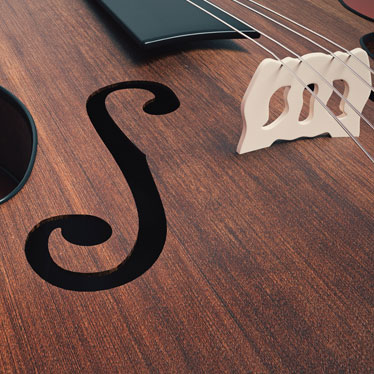When Is It Time to Change Your Strings?

Knowing when to change your violin strings is an important part of being a violinist. Change them too often, and you’ll be spending quite a bit of money, which may not even be necessary. However, if you don’t change them when you need to, the drawbacks can be very serious. In addition to sounding bad (and thinking you’ve lost all your abilities), worn out strings are more likely to break while playing, which can be dangerous, and you have to use more pressure to produce sound. That type of playing often causes stress-related wrist and shoulder injuries that can be serious.
Because the symptoms of string deterioration vary according to the type of strings you’re using, your instrument type, and how often you play, you’ll need to take an overall look at your string needs. Since these tips address the conditions that cause string wear-and-tear, they can help you understand exactly when you need to replace your worn out, old violin strings.
Causes
Strings wear out for a variety of reasons. By understanding the causes, you’ll be better able to ascertain their condition.
Playing Habits—Although this isn’t the most reliable indicator, the amount of time you spend playing your violin can give you a good estimate of when your strings need replacement. If you practice and play about one hour each day, you should replace your strings every 4 to 6 months. Extended hours of performances and practice times can lower the time frame to around every 1 to 3 months, depending on the string condition. Regardless of how often you play, your violin strings should be replaced at a minimum of every 9 to 12 months.
String Material—Certain materials wear out faster than others. For example, violin strings that are made from gut sound very rich, but the material doesn’t last as long as steel fabricated strings. And although they last longer, steel isn’t always a favorite choice for classical musicians. Synthetic nylon strings, like those in Thomasik-Infeld’s Dominate or Alphayue string line, combine longevity with warmth, creating a string that sounds great and has lasting power.
Instrument Set-up—In some cases, the way your bridge has been cut, or the nut on your violin will negatively impact the strings, making them wear out sooner than normal. If the grooves on these parts aren’t cut correctly, the agitation can increase the stress on the string at those points, shortening their lifespan.
Contact—Oils from your hands, dirt, and rosin build up, which makes contact with your violin strings. This can cause them to wear out faster than normal. To prevent this, make sure to wipe your strings off with a dry cloth each time you finish playing. Also, the winding around the strings (except the E) can fray and begin to unravel, especially at the point of contact on the fingerboard. If that occurs, replace the string right away. Playing with a frayed string is perilous.
Making String Assessments
Obviously, some string damage can’t be ignored. If any of your strings break, they’ll need to be replaced immediately. So, it's a good idea to always carry a backup set of violin strings. If the set you’re using isn’t brand new, go ahead and replace the whole set when one string breaks. Since you don’t want one string to sound completely different from all the others, switching out all of the old ones is a good idea.
Tuning Difficulties—If your strings are hard to tune (taking lots of adjustments to finally achieve the right pitch), or if your strings need tuning all the time, even during a practice session, odds are that they’re spent. Replace them.
Sound Quality—Perhaps you recognize that you just can’t achieve the resonance you normally have, or you’re having a hard time with vibrato and you have to add more and more pressure with your bow. This is also a good indication that your strings need to be replaced.
General Dissatisfaction—Maybe there’s not any damage to speak of? That doesn’t mean you shouldn’t replace your violin strings. Sometimes a new set of strings can energize your playing and revitalize your inspiration. With the Alphayue set only costing about $20, you can afford to replace your strings even if they aren’t wrecked beyond use. Plus, it’s a good policy to keep an extra set of “stretched” strings handy in case you have an emergency break at a concert or recital.
The strings on your violin have a big impact on the playability and resonance you’re able to achieve. Don’t be afraid to replace your strings when you think they might need it. As long as you follow the proper procedure, generally you’ll be amazed at the difference you’ll hear.


